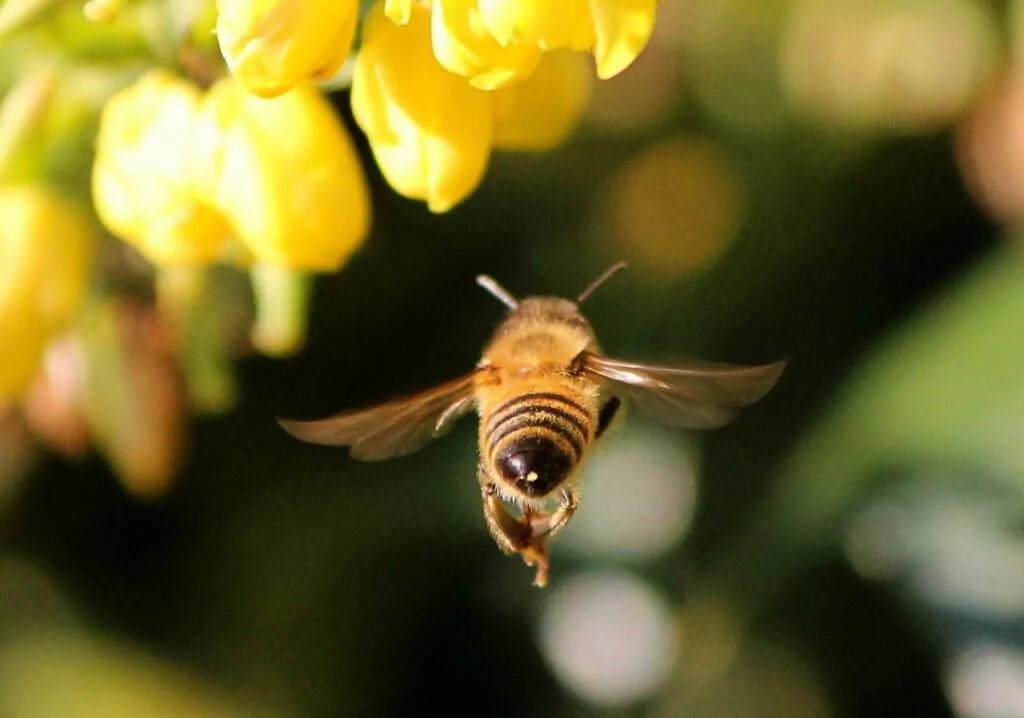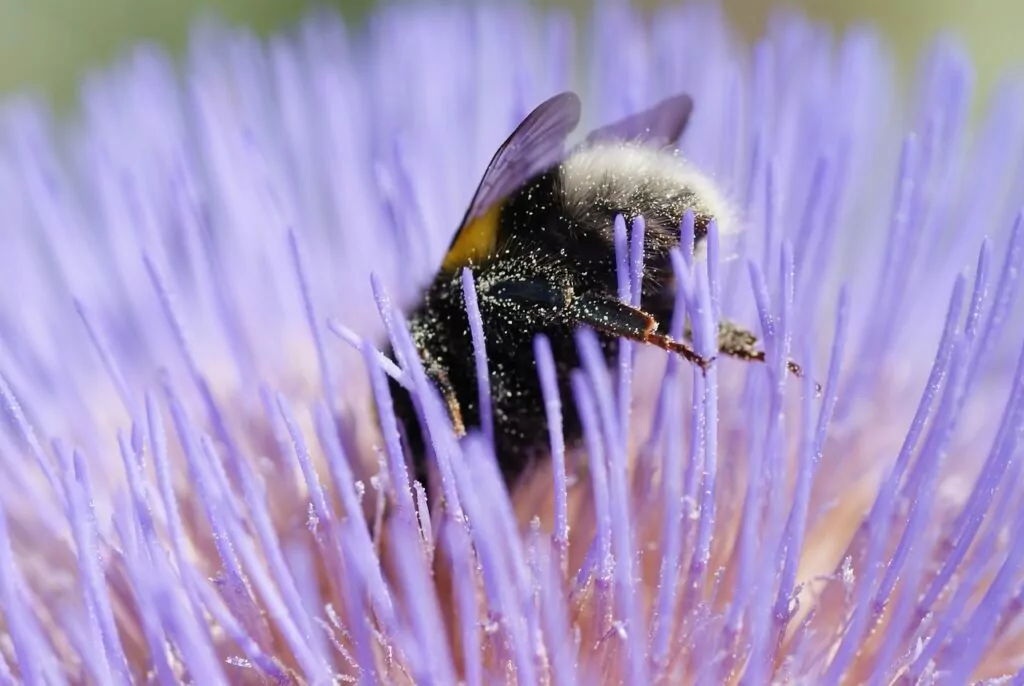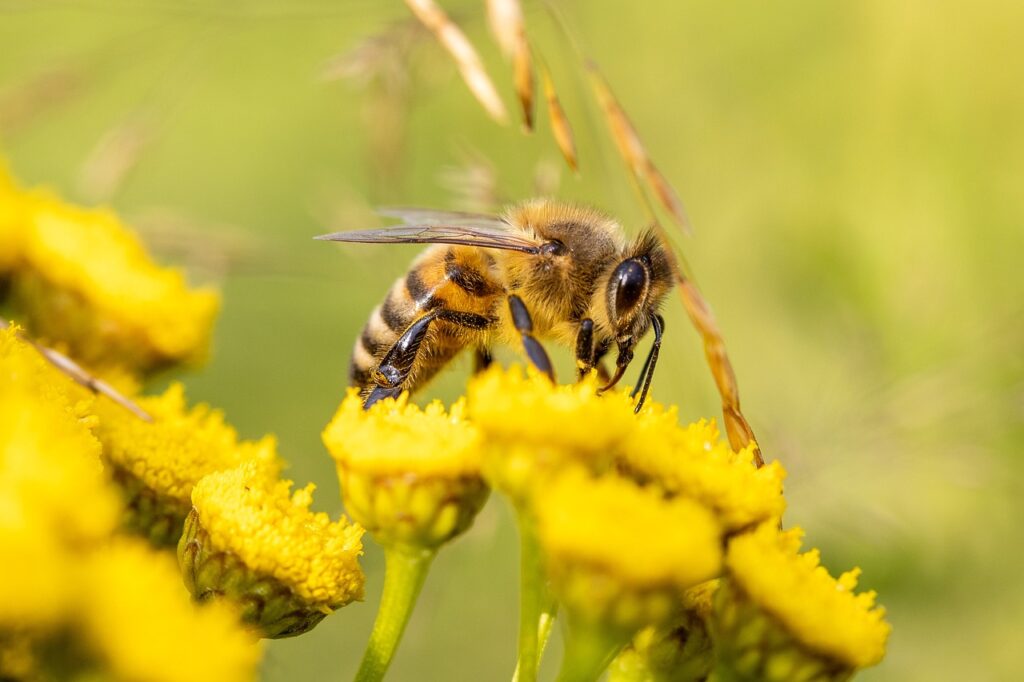
How far do bees travel? Though we rarely think of honeybees’ daily lives outside beehives, many leave their hives daily. Bees will often migrate to a source of pollen, nectar, and water.
Knowing where bees travel and how far afield they fly can help beekeepers better understand their honeybees’ needs and how to better promote the health of their hive. It can also help the average person promote the health and safety of their local pollinators, leading to more bountiful gardens and a thriving local ecosystem.
How Far Do Bees Travel?
Most people will be surprised to learn that bees can fly as fast as 35km per hour! However, they will unlikely travel this far for pollen, nectar, or water. Instead, the average bee will only travel within 3km from their beehives at most to forage, assuming there are food sources nearby, and many other bees will only travel within 1km. Some bees have been known to fly as far as 12 to 20km to find sustenance.
Of course, there are different bee species with varying travel habits. Let’s take a look at three types of bees:
● Honeybees: these bees typically travel between 1 and 6 km, though they may rarely travel as far afield as 20 km. In winter, they travel most closely to the hive to preserve their energy in colder temperatures.
● Bumblebees: bumblebees also travel to forage pollen and nectar but travel less extensively than honeybees. They put more effort into conserving their energy and make shorter foraging journeys.
● Solitary Bees: Like the bumblebee, the solitary bee prefers to travel shorter distances to conserve energy. They tend to only fly between 1 to 2.5 km.

The Role of Nectar and Pollen in Bee Travel
Nectar and pollen are two of the most important food sources for bees, and of course, these plants also need bees for pollination. These two natural substances are the central driving force that causes bees to leave their hives and travel short and long distances. If you’re wondering how far bees travel, the nearest nectar and pollen locations help to answer that question.
But why are nectar and pollen such essential resources for bees? Well, both substances provide valuable nutrition to these tiny insects.
Nectar
Carbohydrates are a great energy source for bees, and nectar provides them with the majority of carbs that they need for fuel. Nectar contains fructose, sugar, sucrose, glucose, and various vitamins and minerals. It is collected by field bees and stored in a sac in the bee’s esophagus, also known as the honey stomach. It is then returned to the hive, where it is processed and stored. Nectar is essential in producing honey and ensuring the survival of the colony.
Pollen
Foraging field bees gather pollen from plant anthers, the male reproductive parts of flowering plants. While many think of cross-pollination as the purpose of this activity, it is also an enormously valuable part of bee nutrition. Pollen provides proteins, fats, vitamins, and minerals for the hive. Field bees gather pollen and return it to the hive, where it is taken and converted into “beebread” by worker bees. Beebread becomes the hive’s primary food source.
Of course, not all bees gather pollen and nectar – for example, only female honeybees collect pollen.
Bees are attracted to many different types of flowers. Still, specific flowers and blooms are more appealing to nectar-gatherers. In fact, certain popular flower species do not provide good nectar at all.
Most bees are attracted to bright flowers, excluding red blooms, which they have difficulty processing visually. They usually prefer a varied diet, from flowers that are open-faced and easy to perch upon. Here are some of the most popular types of flowers that bees will travel further afield to gather from:
● Sunflower
● Daisy
● Lupine
● Lavender
● Bee Balm
● Goldenrod
● Clematis
● Borage
● Aster
● Black-Eyed Susan
● Zinnias
● Peony
● Pansy
● Phlox
But of course, bees will travel for plenty more flower species. If you want to grow bee-friendly plants that provide sustenance for local pollinators, consider looking into similar species that grow best in your climate.

When discussing bee travel, it’s natural to consider more than just ‘how far do bees travel?’ We should also ask how these tiny insects manage to identify and navigate to food sources over a mile away. After all, this is one of the most exciting factors of bee navigation. So how do bees find their food?
Well, several factors influence bee navigation.
Scent
Bees have a powerful sense of smell that allows them to locate pollen and nectar sources. They use their antennae to identify the scent, where it is, and how far away.
Landmarks
Landmarks and landscapes play an essential part in bee navigation. While the scent is a decisive factor in locating food sources, these insects can still use sight to help them go to and from these sources. Bees choose local landmarks to help them return to pollination sites they have already traveled to. They select these landmarks based on their “uniqueness, conspicuousness, stability, and context,” according to one 2019 study on the role of landscapes and landmarks in bee navigation.
Sun
The sun also plays an essential part in bee navigation. Bees will use the sun’s angle to help guide them toward pollen and nectar sources. They will then keep the same angle between their flight path and the sun, ensuring they can repeat the same route back to the hive.
The “Waggle” Dance
But finding food sources is more complex than one bee finding some pollen and nectar and simply using that source on their own. Bees are part of a colony and work together to find the most valuable pollination sources.
So when one bee finds a flower patch with a high yield of nectar and pollen, it’s its job to communicate the location to the rest of the colony so they can gather as much nectar and pollen as possible.
Bees communicate flower location with a special “dance” called the waggle dance. The waggle dance is a series of flight movements that allow a bee to communicate the distance and direction of the flower patch to the rest of the hive.
First, the bee will fly in a straight line (known as the waggle run) while waggling its body before flying back around and repeating the waggle run. The line length shows the other bees how far the flower patch is from the hive. They also perform the waggle run at an upward angle. This is the angle other bees will use to identify the direction of the flower patch by flying away from the sun at the same angle.
The Impact of Human Activity on Bee Travel
While bees have been traveling for food for millions of years, modern human activity has made it increasingly more difficult for these insects to find sufficient pollen and nectar sources near their hives.
Human activity has had a damaging effect on bees and bee travel in several ways. Increasing urbanization worldwide has led to habitat destruction and loss, effectively destroying many of the average bees’ most plentiful food sources. Urbanization has also led to “a decline in medium- and large-bodied ground-nesting female bees,” according to the University of Michigan Record. Since male and female bees tend to pollinate different flower species, this has restricted which plants can be pollinated. And, of course, fewer female bees mean overall declining reproduction rates amongst bee populations.
Pesticides are another side effect of human activity impacting bees and their food sources. When foraging, many bees will feed on plants and flowers exposed to pesticides, killing the bees and stunting population growth. According to studies at the University of California, pesticide exposure can lead to 44% fewer offspring in affected bees.

The Importance of Bees to Global Ecosystems
Believe it or not, the travel patterns of our bee friends and their methods of feeding and foraging play an essential part in maintaining the health of our planet.
Bees are the most common pollinators. Traveling from place to place and carrying pollen from plant to plant allows plants to spread, grow, and reproduce. Over 250,000 flowering species depend on cross-pollination to reproduce, which is primarily carried out by bees.
Their role as global pollinators allows most plant species to survive and thrive and has an enormous impact on global food systems. 35% of world crop production and plant-based medicine production depends on pollinators, of which bees make up the most significant percentage. Without bees, it would take billions of dollars to pollinate those same crops manually.
How You Can Support Bees and Their Travel Patterns
Now that we know our fuzzy yellow friends and their travel instincts are vitally important, how can we help make travel easier for them? Thankfully, beekeepers, and humans in general, can do many things to support our bee friends and make it easier for them to source pollen and nectar.
Plant The Right Flowers
If you have the space for it, planting bee-friendly flowers is an excellent way to help your local pollinators. You don’t need much land either – even flower pots or window boxes will make a big difference! This will save local bees from having to travel long distances and potentially keep them from feeding on plants sprayed with pesticides. This is also a helpful practice for any beekeeper since plenty of local flowering plants mean a better honey yield.
No More Pesticides
Do your local bees a favor and remove pesticides from your backyard maintenance. It will directly benefit the bees by removing any risk of adverse side effects, and some pest plants you kill can provide food for these bees.
Plant Through The Seasons
Consider planting flowers that can provide nectar and pollen at varying times of the year and throughout the growing seasons. After all, bees need sustenance beyond springtime.
Create Nesting Spots or ‘Bee Hotels’
Bees need a shelter where they can nest and hibernate. You can create makeshift nesting sports for your local bees or even purchase readymade bee’ hotels’ made of stacked tubes to mimic their natural nesting spaces. If you have any tree stumps or untreated lumber on your property, you can drill holes for bees to take up residence.
Many bees also nest in the ground, so simply providing patches of dry, undisturbed land will give them space for nesting and raising their young.
Learn As Much As You Can
Above all, learning as much as you can about bees and their travel patterns is one of the best ways that you can help to protect them. With enough reading and research, you will learn to identify different types of bees in your area and how to help these local bees survive and flourish.
Final Thoughts
Bee travel beyond the confines of their hive is essential. These valuable insects need nectar and pollen to sustain life within their colonies, allowing them to create honey and continue pollinating much of the plant life within a 20km radius.
While bee travel and navigation may not seem that important to humans at first glance, that couldn’t be further from the truth. Ensuring that bees have safe nectar and pollen sources within reach means helping local plant life grow and reproduce. It’s up to us humans to help make their journeys a little easier. Safer navigation for bees means a healthier planet for everyone else!
- Does Bleach Kill Bees? - April 23, 2024
- How Do I Get Rid of Ants Without Harming Bees? - April 16, 2024
- Do Bug Zappers Kill Bees? Completely Explained - April 9, 2024
